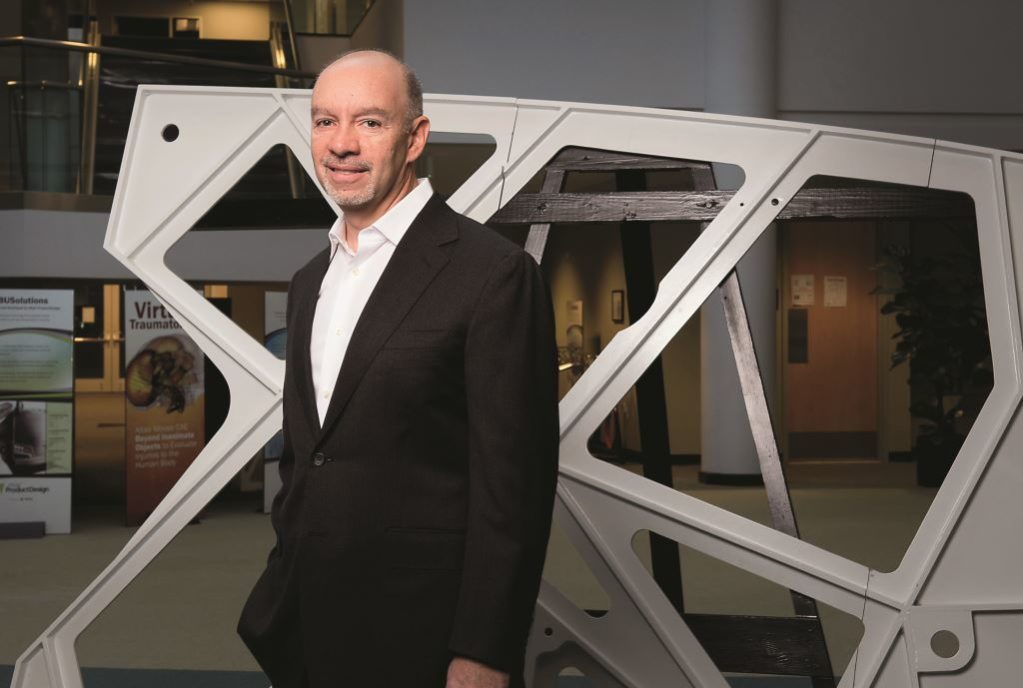The future of architecture is evolving before my eyes on the laptop of Luca Frattari. In a series of keystrokes the architectural engineering Ph.D., now a business development manager at software firm Altair, thins out the blocky outer shell of a new skyscraper into a willowy exoskeleton that would stand out even among the gaudier designs in the Dubai skyline. Its irregular lattice leaves room for giant, undulating pools of window glass. Yet when he runs a wind-flow analysis on the simulation, the building’s organic form wicks away stiff breezes far more efficiently than a rectilinear structure. And the reduction in outer material gives the building an excellent chance of going up faster and for less money.
More things should look bony. Millions of years of evolution have honed the skeleton into the perfect shape for survival. Our hollow, long bones are thick and strong where needed, and light and flexible where possible. Their excesses were purged long ago.
Adapting nature’s forms to human problems, a trend called biomimicry, is an idea that has taken root at engineering-intensive firms such as Ford, General Motors, Boeing and Airbus, all of them hungry buyers of technology to improve the shapes of the machines and structures they build. The biggest computer-aided engineering software firms, Ansys, Dassault Systèmes and LMS International, a Siemens subsidiary, have enjoyed double-digit revenue growth in recent years as large customers snap up their pricey suites of simulation and material analysis software. Unseen by drivers and frequent fliers, the straight angles and solid forms under the skins of autos and airliners have been replaced over the past several years by funky-looking ribs that are lighter and stronger than the original. For each hundred pounds trimmed off a car, drivers could save about 1% to 2% on fuel economy, which could add up to billions of dollars nationally, according to the U.S. Department of Energy. Even shaving 1 gram off a water bottle would eliminate 160 million pounds of material per year, assuming consumption of 200 million bottles per day, says Thierry Marchal, Ansys’ director of industry marketing for consumer goods.
Altair of Troy, Mich. has a lead over its rivals in a particularly interesting field called topology optimization, according to research firm CIMdata. Altair’s OptiStruct software simulates on metal and carbon-fiber structures the same trial-and-error forces that have shaped bone growth over millennia—but repeats them at semiconductor speed until an engineer arrives at a design that meets the need without any excess material. The process can lead to unique and sometimes nonintuitive shapes that are often 20% to 30% lighter than traditionally formed structures.
The privately held company, cofounded by CEO James Scapa, a Ford veteran, and two others in 1985, got half of its estimated 2012 revenue of $240 million (up 13% from 2011) from the auto industry but is growing 30% year over year in aerospace and electronics, three times the growth of its steady auto business. Airbus used Altair software to shed a thousand pounds off the A380 by redesigning 13 wing ribs on each side of the plane. Altair now works with more than 3,000 clients, including Boeing, Lockheed Martin, NASA and the Department of Defense, but it is rapidly spreading the gospel of evolutionary perfection to a wider audience in consumer products and infrastructure and among commercial architects.
Loading...
In October Altair released what it says is the first simulation and analysis software designed to be easily used by the engineering masses. Called solidThinking Inspire, it will be bundled into Altair’s flagship software package ($20,000 on average) or sold separately for $8,000. Early adopters of Inspire include auto supplier Key Safety Systems and the Pratt Institute in New York. Architects in the U.S. and Europe are planning high-rises to be unveiled later this year in Asia that will look like descendants of the biomorphic forms created by Antoni Gaudi and Frei Otto.
Altair got its inspiration for bone-based software 20 years ago when Scapa and his chief technology officer, Jim Brancheau, found Jeff Brennan in a lab at the University of Michigan. Brennan was a biomechanical engineer studying how humans bones grow; Scapa brought Brennan in to oversee what would become OptiStruct. Brennan spent the early 1990s schlepping a computer from one carmaker to another, struggling to get analytical engineers to accept his OptiStruct software’s counterintuitive visual results. After OptiStruct became part of Altair’s bigger HyperWorks software suite and no longer needed individual salesmen, Brennan eventually took over as CMO. “We brought Jeff in, and for years and years the competition couldn’t see why we did it—they said there was no market,” Scapa says. “Now they are trying to catch up.”
Altair says it has grown at a 14% compounded annual rate since 2004 but has no plans to go public. It is majority owned by its three founders and last raised money eight years ago selling an undisclosed minority stake to General Atlantic for $30 million. Scapa aims to reach $1 billion in revenue by 2020, a stretch goal that largely depends on how much Inspire broadens the user base.
Even if Altair fails to hit the billion-dollar goal, it will be an aesthetic victory for the rest of us as more buildings, cars, trains and gadgets take on the swooping curves beloved by nature.
Loading...
